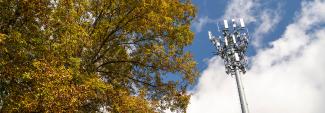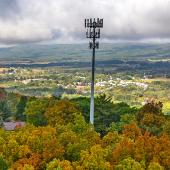This blog is a repost from the Catron Courier, originally published on September 1, 2021.
Every day first responders step out into the frontlines to protect and serve their communities. In the last decade, firefighters, law enforcement officers, and EMS professionals nationwide rarely responded to incidents without bringing their mobile devices.
The tech revolution has made it possible for first responders to do things previously not imagined. Nowadays, first responders load their mobile phones with apps to wield drones during search and rescue missions, monitor tornadoes, pull up floor plans in burning buildings, and much more.
As exciting as technology can be, it also has its limitations—especially in crowded spaces or rural areas. When incidents happen, the first thing we do is reach for our phones to update family and friends and make sure that everyone is safe. This heavy communication activity can overwhelm networks. When this happens, first responders who rely on the same network as the public may find it difficult to communicate during times of need.
Our nation’s first responders have long known that reliable communication is key to serving their communities.
That’s why they joined together to rally for a network designed exclusively for public safety. The result of their hard-fought effort is FirstNet – a communications “fast lane” that gives responders their own channel to communicate.
As we planned for this network, the First Responder Network Authority worked hand in hand with New Mexico’s public safety to build a network that would meet their unique needs. Today, FirstNet is a reality and New Mexico’s first responders are experiencing the benefits of their network.
During the Albuquerque International Balloon Fiesta, FirstNet made communication much easier. In years past, when crowds swelled over 900,000, responders experienced slow or lost signals. With FirstNet, public safety had a different and better experience. Whether using FirstNet to power drones to monitor air space or share images to reunite lost children with their families, FirstNet did what it was built to do.
FirstNet has been on the front lines with tribal nations in New Mexico during the coronavirus. When the vast and rural Navajo Nation was hard-hit by COVID-19, FirstNet sent two Satellite Cells on Light Trucks (SatCOLTs) to the reservation. These mobile units helped tribal first responders and health care workers coordinate and deliver food, medicine, and supplies to help save lives.
After local responders identified areas lacking coverage, FirstNet built two new cell sites in Catron and Hildalgo counties. This means that these rural first responders have the same capabilities to communicate as their public safety colleagues using FirstNet in Albuquerque, Santa Fe, Farmington, Roswell, and Hobbs.
As the Senior Public Safety Advisor for New Mexico, I am dedicated to making sure New Mexico’s first responders’ broadband communication needs are met. Recently, I met with state and local leaders to discuss the ways agencies throughout the state are testing FirstNet assets like MegaRange, FirstNet Push-to-Talk and High Power User Equipment. This cutting edge technology will be a critical resource for responders when responding to situations in remote parts of the state. The feedback I gather from these engagements is important to understanding current and future critical communications needs and it ensures that public safety has the necessary tools to keep communities across New Mexico safe.
To learn more about FirstNet or if you’d like to talk to me about how FirstNet can connect responders in your area, send me an email at: Thomas.Randall@firstnet.gov.




















